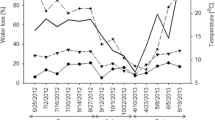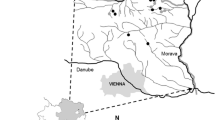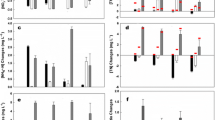Abstract
Intact sediment-water columns from a flowing cypress swamp receiving primary wastewater effluent were used to evaluate inorganic N removal and to determine the fate of 15NH sup+inf4 -N added to the floodwater. Treatments represented wetland sites which had received 0 (initial application), 2, and 50 years of primary wastewater application. The rate of inorganic-N decrease in the floodwater was greatest for the initial application columns, primarily due to sediment adsorption of NH sup+inf4 , followed by 2-year and 50-yr-columns. Maximum removal rates were 318, 296, and 148 mg N m−2 day−1, respectively. At the end of the 21-day study period, only 0.5 to 2.3% of applied 15N was recovered in the floodwater and 11.4 to 17.3% was recovered in the sediment, with the remaining 82.2 to 86.3% being lost from the sediment-water system. Results of the study indicated that N removal efficiency did not decrease with prolonged wastewater application, despite reduced sediment adsorption capacity, because of the significance of gaseous N losses (nitrification-denitrification, NH3 volatilization) as an N sink in the sediment-water system.
Similar content being viewed by others
References
American Public Health Association, 1980. Standard methods for the examination of water and wastewater. 15th ed. American Public Health Association, Washington, D.C. 1134. pp.
Boyd, C. E., 1970. Vascular aquatic plants for mineral nutrient removal from polluted waters. Econ. Bot. 24: 95–103.
Bremner, J. M. & C. S. Mulvaney, 1982. Total Nitrogen. In Methods of Soil Analysis. Part 2., A. L. Page (.). Agronomy 9: 595–624. Amer. Soc. Agron., Madison, WI.
Boyt, F. L., S. E. Bayley & J. Zoltek, Jr., 1977. Removal of nutrients from treatment municipal wastewater by wetland vegetation. J. Water Pollut. Control. Fed. 48: 789–799.
Brezonik, P. L. & G. F. Lee, 1968. Denitrification as a nitrogen sink in Lake Mendota, Wisconsin. Environ. Sci. Techn. 2: 120: 125.
Chen, R. L. & D. R. Keeney, 1974. The fate of nitrate in lake sediment columns. Water Res. Bull. 10: 1162–1172.
Conner, W. H. & J. W. Day, Jr., 1976. Productivity and composition of a baldcypress-water tupelo site and a bottomland hardwood site in a Louisiana swamp. Am. J. Bot. 63: 1354–1364.
Dierberg, F. E. & P. L. Brezonik, 1984. Nitrogen and phosphorus mass balances in a cypress dome receiving wastewater. pp. 112–118. In K. C. Ewel & H. T. Odum (eds), Cypress Swamps. University Presses of Florida, Gainesville. 472 pp.
Engler, R. M. & W. H. Patrick, Jr., 1974. Nitrate removal from floodwater overlying flooded soils and sediments. J. Envir. Qual. 3: 409–413.
Gersberg, R. M., B. V. Elkins & C. R. Goldman, 1983. Nitrogen removal in artificial wetlands. Water Res. 17: 1009–1014.
Hauck, R. D., 1982. Nitrogen-isotope-ratio analysis. 735–776. In A. L. Page (ed.) Methods of Soil Analysis, Part 2. Chemical and Microbiological Properties. Second Edition Am. Soc. of Agronomy, Madison, WI.
Keeney, D. R. & D. W. Nelson, 1982. Nitrogen — Inorganic forms, pp. 643–693. In A. L. Page (ed.) Methods of Soil Analysis, Part 2. Chemical and Microbiological Properties. Second Edition. Am. Soc. of Agronomy, Madison, WI.
Lakshman, G., 1979. An ecosystem approach to the treatment of wastewaters. J. Envir. Qual. 8: 353–361.
Nessel, J. K. & S. E. Bayley, 1984. Distribution and dynamics of organic matter and phosphorus in a sewage-enriched cypress swamp. In K. C. Ewel and H. T. Odum (ed.) Cypress Swamps. University Presses of Florida, Gainesville: 262–278.
Reddy, K. R. & W. F. DeBusk, 1984. Growth characteristics of aquatic macrophytes cultured in nutrient-enriched water: I. Water hyacinth, water lettuce, and pennywort. Econ. Bot. 38: 225–235.
Reddy, K. R. & W. F. DeBusk, 1985. Nutrient removal potential of selected aquatic macrophytes. J. Envir. Qual. 14: 459–462.
Reddy, K. R. & W. H. Patrick, Jr., 1984. Nitrogen transformations and loss in flooded soils and sediments. In Critical Reviews in Environmental Control, Vol. 13, Issue 4. CRC Press: 273–309.
Reddy, K. R., W. H. Patrick, Jr. & R. E. Phillips, 1980. Evaluation of selected processes controlling nitrogen loss in a flooded soil. Soil Sci. Soc. Amer. J. 44: 1241–1246.
Reddy, K. R., K. L. Campbell, D. A. Graetz & K. M. Portier, 1982. Use of biological filters for treating agricultural drainage effluents. J. Envir. Qual. 11: 591–595.
Spangler, F. L., C. W. Fetter, Jr. & W. E. Sloey, 1977. Phosphorus accumulation-discharge cycles in marshes. Water Res. Bull. 13: 1191–1201.
Tilton, D. L. & R. H. Kadlec, 1979. The utilization of a freshwater wetland for nutrient removal from secondarily treated wastewater effluent. J. Environ. Qual. 8: 328–334.
Wolverton, B. C. & R. C. McDonald, 1979. Upgrading facultative wastewater lagoons with vascular aquatic plants. J. Water Pollut. Control Fed. 51: 305–313.
Author information
Authors and Affiliations
Additional information
Florida Agricultural Experiment Stations Journal Series No. 7712
Rights and permissions
About this article
Cite this article
DeBusk, W.F., Reddy, K.R. Removal of floodwater nitrogen in a cypress swamp receiving primary wastewater effluent. Hydrobiologia 153, 79–86 (1987). https://doi.org/10.1007/BF00005506
Received:
Revised:
Accepted:
Issue Date:
DOI: https://doi.org/10.1007/BF00005506




